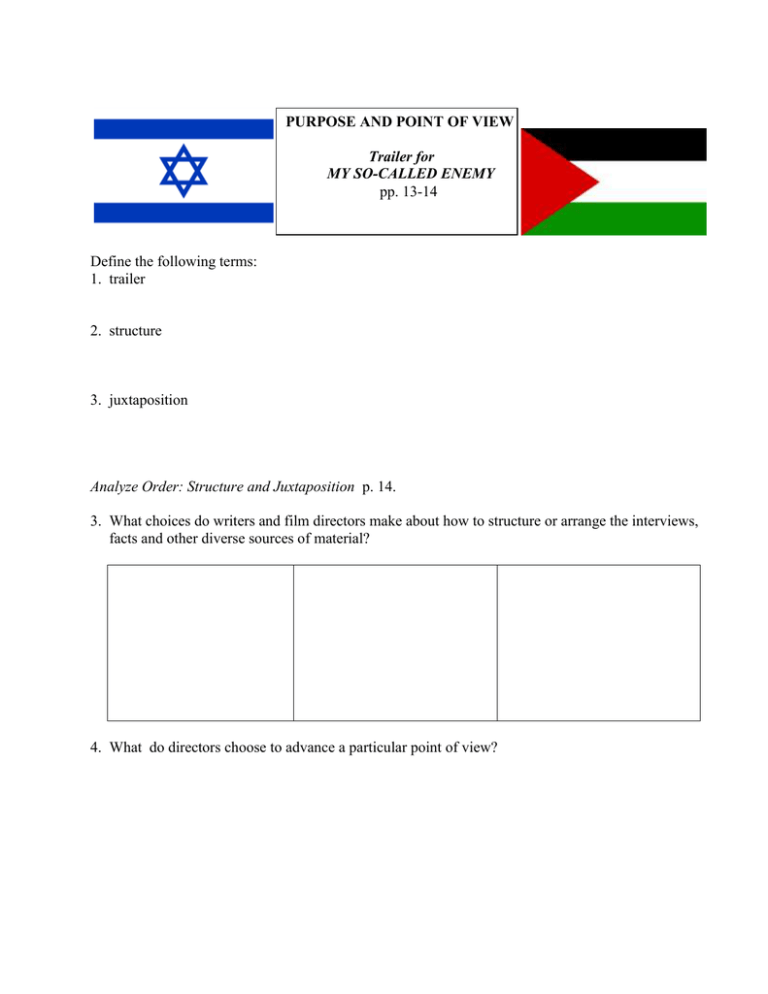My So-Called Enemy ws and test
advertisement

PURPOSE AND POINT OF VIEW Trailer for MY SO-CALLED ENEMY pp. 13-14 Define the following terms: 1. trailer 2. structure 3. juxtaposition Analyze Order: Structure and Juxtaposition p. 14. 3. What choices do writers and film directors make about how to structure or arrange the interviews, facts and other diverse sources of material? 4. What do directors choose to advance a particular point of view? Trailer for MY SO-CALLED ENEMY pp. 13-14 1. After viewing the first 29 seconds, identify the elements that set the time and place. Evidence Inferences 2. The overall purpose of a trailer is to persuade viewers to watch the full-length film. A film director’s arrangement of shots and use of media features reflect a specific purpose or point of view. a. After viewing the first 1:05 minutes, identify the director’s purpose. 3. a. Stop at 2:43. Jot evidence and inferences on the chart. b. Stop at 3:00. Jot evidence and inferences on the chart. 4. Interpret a. Identify the ways the conflict and people are introduced and developed in the trailer. b. Which shots or scenes most help you understand the situation the girls face? c. Why? 5. Evaluate a. List and describe examples of media techniques used in the trailer, including news reports, music, and on-screen text. b. Which technique or example do you find most effective in achieving the director’s purpose? c. Why? 6. Analyze a. Describe the shots that immediately follow Inas explaining her conflicted feelings about Jews. b. What is the effect of these shots? c. How does this juxtaposition serve the director’s purpose? QUIZ: Trailer for MY SO-CALLED ENEMY pp. 13-14 Comprehension Read each of the following questions. Then choose the letter of the best answer. 1. At the beginning of the video, a news announcer says that Israel will not stop the bombing until the Palestinians cease rocket fire. What can you infer about the nature of the conflict between the two sides based on this statement? a. One side is clearly the aggressor in the conflict. b. The two sides are locked in a cycle of violence. c. The two sides are equally matched in their weapons. d. Neither side wants a peaceful solution to the conflict. 2. The tone in the chat message exchange between Gal and Rezan early in the trailer might be described as a. angry. b. cautious. c. concerned. d. suspicious. 3. How does Hanin respond to Gal's argument that the Jews need to be in Palestine because of the Holocaust? a. She agrees with Gal's argument completely. b. She argues that Jews should live in another place. c. She asks Gal to explain what the Holocaust was. d. She denies that the Holocaust took place. 4. Inas asks Adi if she would work for peace. Adi says a. politics are not important to her. b. justice and understanding are more realistic. c. peace is her highest priority. d. there is no hope of peace between them. 5. When Inas remembers that the girls with whom she is eating and dancing are Jewish, she has mixed feelings because she knows that a. a Jew took her father's job. b. the Jewish girls are not friendly. c. a Jewish family took her house. d. Jewish people killed her father. 6. What message do images of the girls playing games communicate? a. Individuals can be friends in spite of political differences. b. Jews and Palestinians must play on separate teams. c. Young people are not aware of differences between them. d. Young people need to be protected from conflict. 7. What structure does the filmmaker use to tell the story? a. flashback and flash-forward b. individual biographies c. problem and solution d. strict chronological order 8. Gal thinks that when she joins the Israeli army her friendship with Rezan might end because a. Israeli soldiers cannot contact Palestinians. b. the girls will fight one another in battle. c. Rezan sees Israeli soldiers at checkpoints. d. Rezan's family will forbid her to contact Gal. 9. What is the meaning of showing symbols of Christianity, Judaism, and Islam near the end of the trailer? a. The region is important to people of all three faiths. b. Christians, Jews, and Muslims have little in common. c. Religious differences make peace in the region impossible. d. The majority religion will gain the most power in the region. 10. What message is communicated through the image of two girls walking next to a high wall? a. Friends must live on the same side of the wall. b. Walls make people on both sides feel safe. c. It is impossible to break down inner walls. d. Physical walls cannot keep people apart. Written Response Answer the following questions based on your knowledge of the trailer. 11. Compare the way the girls dress in New Jersey with the way they dress back home and explain how their clothing relates to the video's central idea. 12. Describe the use of music in the film and explain how it supports the director's purpose.




